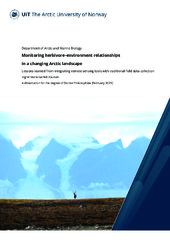| dc.description.abstract | Arctic herbivores face a rapidly changing environment, impacting their habitat use and food resources. Understanding the extent and future impact of suitable habitats is crucial. However, studying herbivore-environment relationships in the Arctic is challenging due to vast distances, remoteness, and landscape heterogeneity. Remote sensing tools like GPS collars, wildlife cameras, drones, and satellites are increasingly used to capture environmental changes and study these relationships.
This thesis investigates habitat use, suitability, and overlap of vertebrate herbivores in High-Arctic Svalbard, evaluating the effectiveness of remote sensing compared to traditional field data. The first objective was to identify seasonal habitat use and suitability for Svalbard reindeer. Key variables included continuous moss tundra, heath, and high vegetation productivity (NDVI) across seasons. Reindeer showed flexible movement patterns, with site fidelity increasing in summer. If current trends continue, suitable habitats and reindeer abundance may increase. The second objective examined habitat overlap among Svalbard reindeer, ptarmigan, and migratory geese. Minimal overlap was found, with geese and reindeer co-occurring in open moss tundra during spring, suggesting some potential for competition. Future tundra greening could increase carrying capacity and competition. The third objective assessed remote sensing tools versus ground-based data in capturing herbivore and plant presence. Field surveys were more effective than drones for reindeer abundance due to limited drone coverage and complex imagery processing. Alien plant species were found in settlements but not near bird cliffs, highlighting the importance of monitoring these alien plant species. Field variables showed clear relationships with high-resolution NDVI, but not always at satellite-relevant scales, complicating NDVI interpretation in Arctic landscapes.
In conclusion, while remote-sensed vegetation proxies (NDVI) correlate with herbivore abundance and habitat suitability, gaps remain between ground-based and remote sensing data. Remote sensing can capture changes in herbivore-environment relationships, but understanding why these changes are happening requires integration with field data. | en_US |
| dc.relation.haspart | <p>Paper I: Paulsen, I.M.G., Soininen, E.M., Ravolainen, V.T., Loe, L.E., Hansen, B.B., Irvine, R.J., … Pedersen, Å.Ø. (2021). Don't go chasing the ghosts of the past: habitat selection and site fidelity during calving in an Arctic ungulate. <i>Wildlife Biology, 2021</i>(2), wlb.00740. Also available in Munin at <a href=https://hdl.handle.net/10037/22155>https://hdl.handle.net/10037/22155</a>.
<p>Paper II: Pedersen, Å.Ø., Soininen, E.M., Hansen, B.B., Le Moullec, M., Loe, L.E., Paulsen, I.M.G., … Ravolainen, V.T. (2023). High seasonal overlap in habitat suitability in a non-migratory High Arctic ungulate. <i>Global Ecology and Conservation, 45</i>, e02528. Also available in Munin at <a href=https://hdl.handle.net/10037/29404>https://hdl.handle.net/10037/29404</a>.
<p>Paper III: Grimsby, A.C., Pedersen, Å.Ø., Ehrich, D., Mosbacher, J.B., Paulsen, I.M.G., Brockmann, F.K. & Ravolainen, V.T. (2023). Spatiotemporal distribution of Arctic herbivores in spring: Potential for competition? <i>Global Ecology and Conservation, 45</i>, e02521. Also available in Munin at <a href=https://hdl.handle.net/10037/30199>https://hdl.handle.net/10037/30199</a>.
<p>Paper IV: Ravolainen, V.T., Paulsen, I.M.G., Eischeid, I., Forbey, J.S., Fuglei, E., Hájek, T., … Pedersen, Å.Ø. (2024). Low spatial habitat overlap of herbivores in the High Arctic tundra. <i>Global Ecology and Conservation, 49</i>, e02797. Also available in Munin at <a href=https://hdl.handle.net/10037/34634>https://hdl.handle.net/10037/34634</a>.
<p>Paper V: Paulsen, I.M.G., Pedersen, Å.Ø., Hann, R., Blanchet, M.-A., Eischeid, I., Van Hazendonk, C., Ravolainen, V.T., Stien, A. & Le Moullec, M. (2023). How Many Reindeer? UAV Surveys as an Alternative to Helicopter or Ground Surveys for Estimating Population Abundance in Open Landscapes. <i>Remote Sensing, 15</i>(1), 9. Also available in Munin at <a href=https://hdl.handle.net/10037/28486>https://hdl.handle.net/10037/28486</a>.
<p>Paper VI: Bartlett, J.C., Westergaard, K.B., Paulsen, I.M.G., Wedegärtner, R.E.M., Wilken, F. & Ravolainen, V.T. (2021). Moving out of town? The status of alien plants in high‐Arctic Svalbard, and a method for monitoring of alien flora in high‐risk, polar environments. <i>Ecological Solutions and Evidence, 2</i>, e12056. Also available at <a href=https://doi.org/10.1002/2688-8319.12056>https://doi.org/10.1002/2688-8319.12056</a>.
<p>Paper VII: Paulsen, I.M.G., Eischeid, I., Pedersen, Å.Ø., Assmann, J.J., Yoccoz, N.G., Mosbacher, J., Soininen, E.M. & Ravolainen, V.T. Vascular plant biomass and herbivore disturbance, but not summer temperature, explain satellite and drone-based NDVI in High Arctic Svalbard. (Accepted manuscript). Now published in <i>Arctic Science, 2025, 11</i>, 1-23, available at <a href=https://doi.org/10.1139/as-2024-0033>https://doi.org/10.1139/as-2024-0033</a>. | en_US |


 English
English norsk
norsk
